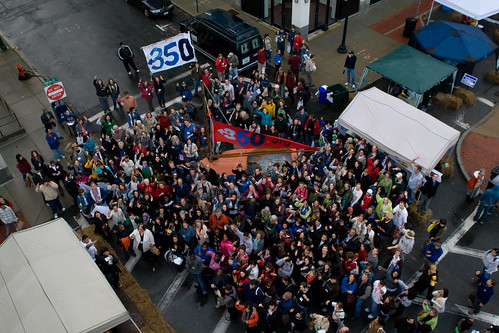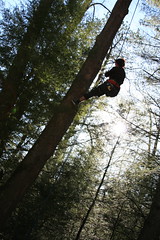This essay originally appeared in Orion Magazine Written by Derrick Jensen
A FEW MONTHS AGO at a gathering of activist friends someone asked, “If our world is really looking down the barrel of environmental catastrophe, how do I live my life right now?”
The question stuck with me for a few reasons. The first is that it’s the world, not our world. The notion that the world belongs to us—instead of us belonging to the world—is a good part of the problem.
The second is that this is pretty much the only question that’s asked in mainstream media (and even among some environmentalists) about the state of the world and our response to it. The phrase “green living” brings up 7,250,000 Google hits, or more than Mick Jagger and Keith Richards combined (or, to look at it another way, more than a thousand times more than the crucial environmental philosophers John A. Livingston and Neil Evernden combined). If you click on the websites that come up, you find just what you’d expect, stuff like “The Green Guide: Shop, Save, Conserve,” “Personal Solutions for All of Us,” and “Tissue Paper Guide for Consumers.”
The third and most important reason the question stuck with me is that it’s precisely the wrong question. By looking at how it’s the wrong question, we can start looking for some of the right questions. This is terribly important, because coming up with right answers to wrong questions isn’t particularly helpful.
So, part of the problem is that “looking down the barrel of environmental catastrophe” makes it seem as though environmental catastrophe is the problem. But it’s not. It’s a symptom—an effect, not a cause. Think about global warming and attempts to “solve” or “stop” or “mitigate” it. Global warming (or global climate catastrophe, as some rightly call it), as terrifying as it is, isn’t first and foremost a threat. It’s a consequence. I’m not saying pikas aren’t going extinct, or the ice caps aren’t melting, or weather patterns aren’t changing, but to blame global warming for those disasters is like blaming the lead projectile for the death of someone who got shot. I’m also not saying we shouldn’t work to solve, stop, or mitigate global climate catastrophe; I’m merely saying we’ll have a better chance of succeeding if we recognize it as a predictable (at this point) result of burning oil and gas, of deforestation, of dam construction, of industrial agriculture, and so on. The real threat is all of these.
The same is true of worldwide ecological collapse. Extractive forestry destroys forests. What’s the surprise when extractive forestry causes forest communities—plants and animals and mushrooms and rivers and soil and so on—to collapse? We’ve seen it once or twice before. When you think of Iraq, is the first image that comes to mind cedar forests so thick the sunlight never reaches the ground? That’s how it was prior to the beginnings of this extractive culture; one of the first written myths of this culture is of Gilgamesh deforesting the plains and hillsides of Iraq to build cities. Greece was also heavily forested; Plato complained that deforestation harmed water quality (and I’m sure Athenian water quality boards said the same thing those boards say today: we need to study the question more to make sure there’s really a correlation). It’s magical thinking to believe a culture can effectively deforest and yet expect forest communities to sustain.
It’s the same with rivers. There are 2 million dams just in the United States, with 70,000 dams over six feet tall and 60,000 dams over thirteen feet tall. And we wonder at the collapse of native fish communities? We can repeat this exercise for grasslands, even more hammered by agriculture than forests are by forestry; for oceans, where plastic outweighs phytoplankton ten to one (for forests to be equivalently plasticized, they’d be covered in Styrofoam ninety feet deep); for migratory songbirds, plagued by everything from pesticides to skyscrapers; and so on.
The point is that worldwide ecological collapse is not some external and unpredictable threat—or gun barrel—down which we face. That’s not to say we aren’t staring down the barrel of a gun; it would just be nice if we identified it properly. If we means the salmon, the sturgeon, the Columbia River, the migratory songbirds, the amphibians, then the gun is industrial civilization.
A second part of the problem is that the question presumes we’re facing a future threat—that the gun has yet to go off. But the Dreadful has already begun. Ask passenger pigeons. Ask Eskimo curlews. Ask great auks. Ask traditional indigenous peoples almost anywhere. This is not a potential threat, but rather one that long-since commenced.
The larger problem with the metaphor, and the reason for this new column in Orion, is the question at the end: “how shall I live my life right now?” Let’s take this step by step. We’ve figured out what the gun is: this entire extractive culture that has been deforesting, defishing, dewatering, desoiling, despoiling, destroying since its beginnings. We know this gun has been fired before and has killed many of those we love, from chestnut ermine moths to Carolina parakeets. It’s now aimed (and firing) at even more of those we love, from Siberian tigers to Indian gavials to entire oceans to, in fact, the entire world, which includes you and me. If we make this metaphor real, we might understand why the question—asked more often than almost any other—is so wrong. If someone were rampaging through your home, killing those you love one by one (and, for that matter, en masse), would the question burning a hole in your heart be: how should I live my life right now? I can’t speak for you, but the question I’d be asking is this: how do I disarm or dispatch these psychopaths? How do I stop them using any means necessary?
Finally we get to the point. Those who come after, who inherit whatever’s left of the world once this culture has been stopped—whether through peak oil, economic collapse, ecological collapse, or the efforts of brave women and men fighting in alliance with the natural world—are not going to care how you or I lived our lives. They’re not going to care how hard we tried. They’re not going to care whether we were nice people. They’re not going to care whether we were nonviolent or violent. They’re not going to care whether we grieved the murder of the planet. They’re not going to care whether we were enlightened or not enlightened. They’re not going to care what sorts of excuses we had to not act (e.g., “I’m too stressed to think about it” or “It’s too big and scary” or “I’m too busy” or any of the thousand other excuses we’ve all heard too many times). They’re not going to care how simply we lived. They’re not going to care how pure we were in thought or action. They’re not going to care if we became the change we wished to see.
They’re not going to care whether we voted Democrat, Republican, Green, Libertarian, or not at all. They’re not going to care if we wrote really big books about it. They’re not going to care whether we had “compassion” for the CEOs and politicians running this deathly economy. They’re going to care whether they can breathe the air and drink the water. They’re going to care whether the land is healthy enough to support them.
We can fantasize all we want about some great turning, and if the people (including the nonhuman people) can’t breathe, it doesn’t matter. Nothing matters but that we stop this culture from killing the planet. It’s embarrassing even to have to say this. The land is the source of everything. If you have no planet, you have no economic system, you have no spirituality, you can’t even ask this question. If you have no planet, nobody can ask questions.
What question would I ask instead? What if, instead of asking “How shall I live my life?” people were to ask the land where they live, the land that supports them, “What can and must I do to become your ally, to help protect you from this culture? What can we do together to stop this culture from killing you?” If you ask that question, and you listen, the land will tell you what it needs. And then the only real question is: are you willing to do it?








 On the same day that dozens of Californians marched to demand renewables in their state, students from all across the country joined Appalachians in Tennessee to march on the TVA headquarters. Organizer Chelsea Ritter-Soronen offers her account of the action...
On the same day that dozens of Californians marched to demand renewables in their state, students from all across the country joined Appalachians in Tennessee to march on the TVA headquarters. Organizer Chelsea Ritter-Soronen offers her account of the action...





